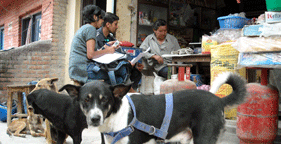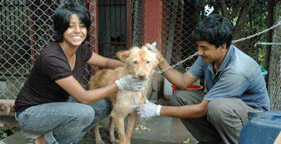Tufts Veterinary Student Studies Humane Dog Population Control in NepalOctober 13, 2009 By Chumkee Aziz This past summer, I received training grants from the Morris Animal Foundation, a nonprofit organization that funds humane research studies, and the Tufts Center for Conservation Medicine to conduct research in Kathmandu, Nepal. I initially approached my primary mentor, Dr. Gretchen Kaufman, with an interest in studying humane dog population control in countries with devastating dog overpopulation problems and high human rabies incidences. Together, we forged the idea of researching the feasibility of using non-surgical sterilization as a means of street dog population control in Kathmandu. Is Non-Surgical Sterilization the Answer? Chumkee Aziz, veterinary student at Tufts, conducting an interview for her research in Nepal. The potential benefit of non-surgical sterilization is that it could be more cost-effective, time-saving, and more humane than other population control methods. Research and development of an ideal non-surgical sterilant for dogs is currently under way. Rabies is a major public health concern in Nepal, with an average of 25,000 people receiving rabies post-exposure treatment and more than 100 people dying from rabies each year. According to World Health Organization guidelines, management of the street dog population that is congruent with the country's socio-economic structure is one major component of rabies control. Both strychnine poisoning, which has been found to be ineffective and inhumane, and surgical sterilization, which is time-consuming and costly, have been used in Kathmandu in attempts to reduce the street dog population. Although an ideal non-surgical sterilant does not yet exist for dogs, the purpose of our study was to analyze the feasibility of using non-surgical sterilization in Kathmandu, and, in doing so, explore potential societal challenges regarding future introduction of non-surgical sterilization. What Does the Future Hold?My interpreter, local veterinarian Dr. Mahesh Bhandari, and I conducted a total of 60 community and 20 veterinary questionnaires to collect data on the social attitude towards the Kathmandu street dog population, its control methods, and interest or opposition to non-surgical sterilization.  Chumkee Aziz with Dr. Bidur Piya at the Kathmandu Animal Treatment Center, one of the only NGOs doing canine ABC in Kathmandu. Hope Partnership Nepal Our findings concluded that although there is general acceptance and support for non-surgical sterilization, there are multiple socio-economic concerns that must be addressed if a non-surgical sterilant is to be introduced in Kathmandu one day. Lack of community awareness regarding dog overpopulation and lack of government involvement in dog population management indicate the need for a government-led national policy on rabies and dog population control that includes public education. Additionally, veterinarians—although generally supportive of the introduction of non-surgical sterilization—expressed concern over the impact that non-surgical sterilization might have on the financial dynamics of private practice. I am hopeful that the data collected in our study will facilitate future implementation of non-surgical sterilization in Kathmandu, and that it may also serve as a model for potential implementation of non-surgical methods in other countries. I thank my school, Tufts Cummings Veterinary Medical School, the Morris Animal Foundation, and everyone who helped me along the way for this incredible learning experience. Not only was I involved in research that is personally important to me, but I also got to realize the beauty of Nepal and met amazing international animal welfare activists all in one summer! Chumkee Aziz is a veterinary student at Tufts Cummings Veterinary Medical School and HSVMA student member. She will graduate in 2012. |
